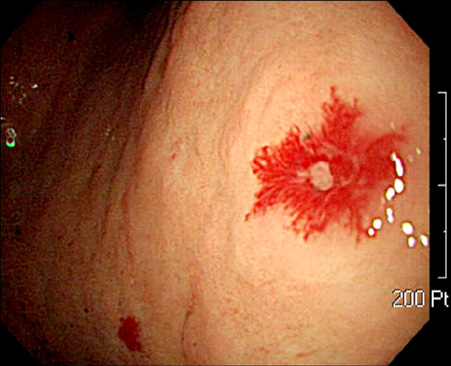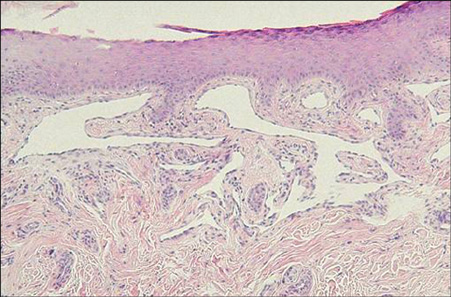Ann Dermatol.
2009 May;21(2):206-208. 10.5021/ad.2009.21.2.206.
A Case of Hereditary Hemorrhagic Telangiectasia
- Affiliations
-
- 1Department of Dermatology, Hanyang University College of Medicine, Seoul, Korea. yuhjoon@hanyang.ac.kr
- KMID: 2219399
- DOI: http://doi.org/10.5021/ad.2009.21.2.206
Abstract
- Hereditary hemorrhagic telangiectasia, also known as Osler-Weber-Rendu disease, is an autosomal dominant disorder of the fibrovascular tissue. It is characterized by the classic triad of mucocutaneous telangiectasias, recurrent hemorrhages, and familial occurrence. The cutaneous manifestation appear clinically as punctuate, linear, or splinter-like telangiectasias of the upper body, oral, and nasal mucous membranes, and nail beds. A 73-year-old woman presented with purpuric, punctuate, and tiny macules on the finger tips of both hands and the tongue. The skin lesions were discovered about 50 years previously. She had a family history of cutaneous telangiectasia. Also, she had episodes of recurrent epistaxis, gastrointestinal bleeding, and anemia. The gastroendoscopy revealed gastric angiodysplasia of the fundus and body of the stomach. The histopathologic study showed dilated capillaries lined by flat endothelial cells in the papillary dermis. From these findings, we diagnosed this case as hereditary hemorrhagic telangiectasia, which has rarely been reported in the dermatologic literature.
MeSH Terms
Figure
Cited by 1 articles
-
Mucocutaneous Telangiectasia as a Diagnostic Clue of Hereditary Hemorrhagic Telangiectasia: An Activin Receptor-Like Kinase-1 Mutation in a Korean Patient
Jimyung Seo, Howard Chu, Jin Sung Lee, Do Young Kim
Ann Dermatol. 2016;28(2):264-266. doi: 10.5021/ad.2016.28.2.264.
Reference
-
1. te Veldhuis EC, te Veldhuis AH, van Dijk FS, Kwee ML, van Hagen JM, Baart JA, et al. Rendu-Osler-Weber disease: update of medical and dental considerations. Oral Surg Oral Med Oral Pathol Oral Radiol Endod. 2008. 105:e38–e41.
Article2. Sadick H, Sadick M, Gotte K, Naim R, Riedel F, Bran G, et al. Hereditary hemorrhagic telangiectasia: an update on clinical manifestations and diagnostic measures. Wien Klin Wochenschr. 2006. 118:72–80.
Article3. Chang DS, Kim MN, Hong CK, Ro BI. A case of hereditary hemorrhagic telangiectasia. Korean J Dermatol. 2002. 40:1148–1150.4. Bossler AD, Richards J, George C, Godmilow L, Ganguly A. Novel mutations in ENG and ACVRL1 identified in a series of 200 individuals undergoing clinical genetic testing for hereditary hemorrhagic telangiectasia (HHT): correlation of genotype with phenotype. Hum Mutat. 2006. 27:667–675.
Article5. Abdalla SA, Letarte M. Hereditary haemorrhagic telangiectasia: current views on genetics and mechanisms of disease. J Med Genet. 2006. 43:97–110.
Article6. Juares AJ, Dell'Aringa AR, Nardi JC, Kobari K, Gradim Moron Rodrigues VL, Perches Filho RM. Rendu-Osler-Weber Syndrome: case report and literature review. Braz J Otorhinolaryngol. 2008. 74:452–457.
Article7. Garzon MC, Huang JT, Enjolras O, Frieden IJ. Vascular malformations. Part II: associated syndromes. J Am Acad Dermatol. 2007. 56:541–564.8. Fernandez-Jorge B, Del Pozo Losada J, Paradela S, Martinez-Gonzalez C. Treatment of cutaneous and mucosal telangiectases in hereditary hemorrhagic telangiectasia: report of three cases. J Cosmet Laser Ther. 2007. 9:29–33.
Article
- Full Text Links
- Actions
-
Cited
- CITED
-
- Close
- Share
- Similar articles
-
- Hereditary Hemorrhagic Telangiectasia in a Family
- Hereditary Hemorrhagic Telangiectasia Combined with Pulmonary Arteriovenous Malformation Treated with Transcatheter Embolotherapy
- A Case of Hereditary Hemorrhagic Telangiectasia
- A Case of Hepatic Involvement in Hereditary Hemorrhagic Telangiectasia Presenting as High Output Heart Failure
- Genetic Mutation Analysis Can Supplement Clinically Confirmed Hereditary Hemorrhagic Telangiectasia Populations




